The Academy expanded the field of visual effects contenders to 20 films this year.
The post 20 Films Shortlisted for Visual Effects Oscar appeared first on Cartoon Brew.
Add a Comment
The Academy expanded the field of visual effects contenders to 20 films this year.
The post 20 Films Shortlisted for Visual Effects Oscar appeared first on Cartoon Brew.
Add a Comment
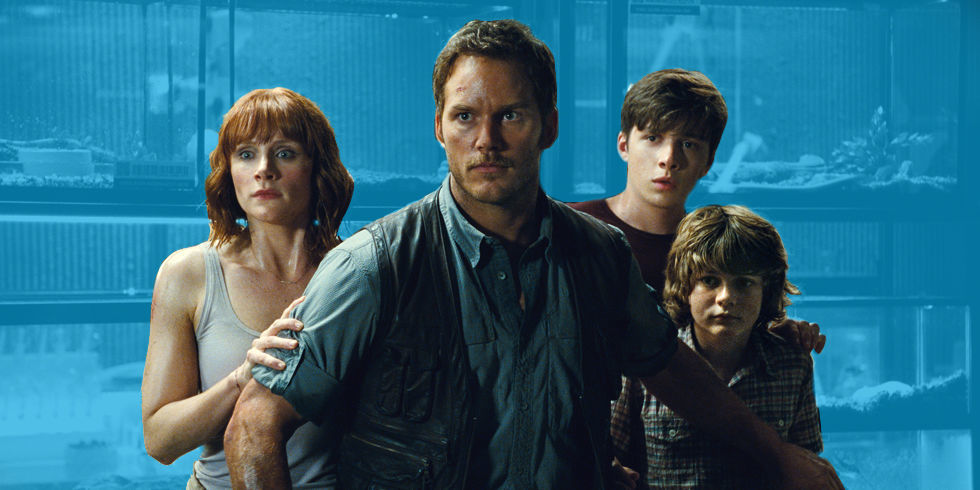 Jurassic World’s ascent to the biggest box office opening of all time has everyone flustered. It’s take of $208.8 million in its first weekend beat even The Avengers which made a mere $207.4 million. (It’s still ahead adjusted for inflation but Gone With the Wind is still the biggest by that metric.) The opening shattered analysts’ projections, leading to a particularly befuddled take by Deadline:
Jurassic World’s ascent to the biggest box office opening of all time has everyone flustered. It’s take of $208.8 million in its first weekend beat even The Avengers which made a mere $207.4 million. (It’s still ahead adjusted for inflation but Gone With the Wind is still the biggest by that metric.) The opening shattered analysts’ projections, leading to a particularly befuddled take by Deadline:
Tracking typically wears the dunce caps in these off-kilter prediction scenarios. However, distrib chiefs sincerely swear NRG, Screen Engine and Marketcast’s systems aren’t broken, and as one forecasting insider asserts: “We’re not paid to predict box office, rather identify pockets of strength, threats and opportunities in the marketplace for the studio. … It’s a five-week journey with daily phone calls.”
Okay so you had a….threat pocket? This wonk talk is Onion worthy.
So as various execs and and analysts around Hollywood drew their own estimates, what truly happened with Jurassic World is that it became a beast unto itself. That’s when the film started over-indexing and beating everyone’s expectations. And the catalyst for the WOM heatwave can be pinned squarely to social media — which, unlike tracking, captured auds’ need-to-see vibe. Adds another Universal insider: “When you go into the weekend, you are armed with your expectations based on historical data, relying on movies released during the same time period as well as assessing different variables in the marketplace. But when the film gets a chance to be itself and grows through the weekend, you lose your historical data.”
While some are still reeling from the over-indexing, Variety had a more sensible deduction: CHRIS PRATT.
“He’s the modern action hero,” said Paul Dergarabedian, senior media analyst at Rentrak. “He’s funny, he’s charming, he’s self-deprecating. I call him Jimmy Stewart in a leather vest. He just has the perfect sensibility for today’s audiences.”
Also…dinosaurs. People like dinosaurs. Bold, I know.
Jurassic World toppling the Avengers is the first blow for a world where superheroes aren’t everything, and makes the generally blah reaction to Avengers 2 look a little more serious. But Jurassic World is still a pretty bland film, as the above still suggests. I know it’s hard to act scared of a screen piece of wall, but look at the kids in that photo. I couldn’t tell if Nick Robinson as the teen heartthrob was supposed to be generally insensate to any outside stimulus, or just no one could take the time to prod him with a stick.
I pretty much agreed with everything that Beat critic Hannah Lodge said about this film. It’s got an awful script, lethargic acting, some nice dinos, and a troubling obsession with running in high heels. Like Lodge, all I could think of during the second half of the movie was whether Bryce Dallas Howard’s Claire was STILL running around in high heels. It turns out Howard made a point of learning how to do it and insisted on wearing them while she was running away from dinosaurs. I knows it’s a fantasy.,.but you can’t run away from dinosaurs in high heels. And there was no internal logic. At one point Pratt’s Owen even mocks her shoes, which YOU’D THINK would set up a scene where she ditches them. I kept expecting her to find some running shoes in the old compound from Jurassic Park but no such luck. She just kept running and running. A line without a payoff…that pretty much sums up the entire Jurassic World script. The one clever thing it did was to combine the predictable roles of Feisty Girl Lead and Annoying Corporate Wonk into one role! Innovative!
Even with that, as a movie, Jurassic World, was on its own fairly low terms, a better film than Avengers 2. I hadn’t memorized the trailer for JW, so when I saw the movie at a screening, I went in thinking “This is going to be a dumb CGI fest but I’m just going to let go, let God, and give in.” I appreciated how the movie had ONE big menace, and all the action was built around a confrontation with that menace, instead of branching off to go to Wakanda to pick up some vibranium and set up three spin-offs—and perhaps audiences did as well. OTOH, if you did memorize the trailer then you pretty much saw everything cool in the movie. But that didn’t stop anyone from going to the theater. It also hit the sweet spot of millennial 90s nostalgia. All we need in the sequel when Dr. Wu pulls out his bag of Indominus Furiosa babys and sets them loose is a cameo for Dr. Ian Malcolm.
As usual the bombastic success of a film with a lackluster storyline has led to lamenting how Hollywood’s hands are tied when it comes to making anything good as Matt Patches writes for Esquire:
This is not just an issue with Trevorrow or his blockbuster. Hollywood’s cynicism is hitting peak levels and continues to trickle into our multiplexes. Movie studio executives would love to greenlight to discover the next Spielberg or nurture a moderately-sized thrill ride into a big-budget classic. But they also want to make money. There are movies that challenge the balancing act with whirlwind intensity; Christopher Nolan’s Inception takes the frustration of imagining and executing action movies and turns it into an action movie. That subtlety is hard to come by. With change and reversion seemingly out of the question, creative types feel compelled to boo and hiss in their movies. Trevorrow employs Jake Johnson to spit his fire. Last month’s Tomorrowland lectured audiences in the dangers of apocalyptic disaster movies. And on the Oscar campaign trail for last year’s Hollywood satire, Birdman, Alejandro G. Iñárritu just came out and say what the film danced around: superhero movies are “cultural genocide.” A few months later, when Birdman won the Academy Award for Best Picture, voters could pat themselves on the back for recognizing great filmmaking. They could make Birdman—isn’t that real cinema? And then the next morning, most of the voters returned to their movie studio jobs and pushed sequels, reboots, and $150 million toy adaptions through the pipeline.
I can’t refrain from adding to the laments however, as I peruse the box office total of Mad Max Fury Road after five weeks: a relatively moderate $138.6 million. It’s made more worldwide, but set against that $200 million budget it’s still not a big moneymaker. HOW! How can this galvanizing, senses-shattering, mind-expanding masterpiece of heart and magic have made only this much when twaddle like Jurassic World is setting records? Why, oh lord, why?
Yes yes, I know, MMFR was R-rated. Meanwhile parents were secretly eager to go see JW with their kids.
Will the religious fervor for the church of George Miller pave the way for an actual sequel? Hard to tell, but I doubt we’ll see Miller allowed to spend money on that level again, alas.
In my previous inquiry into the actual reason that people found the practical effects of Mad Max Fury Road so profoundly affecting compared to CGI spectacle, I didn’t find much from a psychological viewpoint, but several people pointed me towards this Cracked piece from a few months ago, 6 Reasons Modern Movie CGI Looks Surprisingly Crappy by David Christopher Bell. This piece sums up some technical reasons for the affectlessness of CGI, using shots from the Jurassic World trailer as examples. Digital grading, unrealistic camera angles, bad physics, and things our minds just reject. For instance this shot of a helicopter falling into a dinosaur:
Sure, that looks pretty awesome, but destruction on that scale should blow our fucking minds. The response to dinosaurs wrecking a helicopter should be nothing short of paralysis, but this scene has no sense of gravity or consequence. There’s no scale to it. There’s even going to be a scene where (minor spoilers) a Pteranodon picks up a woman and literally drops her into the mouth of the Mosasaurus. It doesn’t matter how real the CGI looks, because that scene belongs in a fucking Sharknado movie. It’s an absurd cartoon orgy.
There’s some more technical discussion at a site that offers AfterEffects plug ins of all places, 10 Reason Why CGI is Getting Worse Not Better, which lays out most of the same arguments as the Cracked piece, with some more scolding over the orange-and-blue digital grading that every movie is saturated with these days, and also “ratcheting up the sequel-itis:”
The CGI in every sequel has a major goal: it has to be more impressive, complex, and crazier than its predecessor. The stakes have to be higher. Filmmakers try to create engagement with more explosions rather than letting story, plot, and character development produce interest.
Another huge issue is that in a world of endless sequels, we no longer have to worry about our main character’s well-being. We don’t need to be invested in the characters because there’s no chance they’ll die. They aren’t in any real peril. The actors have already signed up for two sequels! James Cameron is working on three Avatar sequels simultaneously! What’s happening now is that filmmakers are making scenes more and more extravagant to offset this sequel fatigue. They keep pushing the limits to keep us saying ‘well surely they can’t survive this’ until it gets utterly ridiculous.
So true. I actually felt that JW was a little moderate in its uses of CGI, but how many big bad dino-hybrids do you think will be in the sequel?
For one little moment, it seemed the rapturous response to Mad Max Fury Road might have Hollywood thinking that more is not better. The unexpected success of Jurassic World has laid that idea to rest, just like you knew it would. It would be nice to think that MMFR might influence some filmmakers to take more chances in that direction, and I don’t doubt that we’ll see endless allusions to it as we did after The Matrix and 300 came out. But given the way Hollywood plucks indie directors out of the schoolyard and gives them huge blockbusters to direct while the SFX unit handles all the action—JW’s Colin Trevorrow had directed one movie previously, and nothing in the film shows the slightest hint of style—it’s not very likely the next generation of action filmmakers will be making waves or demands. These days moviemaking is just too expensive and leviathan to take chances.
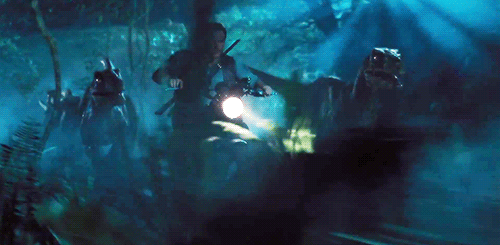
And you know, Chris Pratt on a motorcycle and his henchdinos. That’s one things CGi is good for.
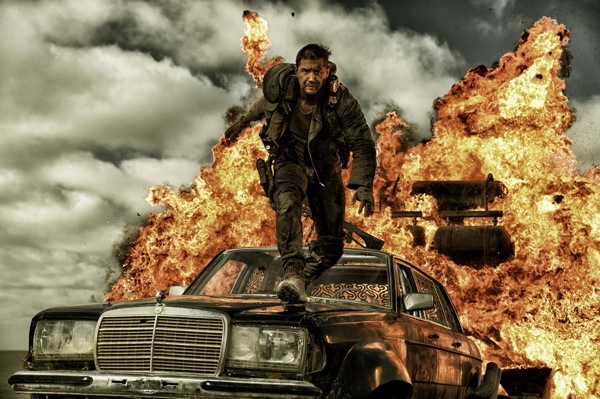
After attending an afternoon showing of Mad Max Fury Road, I stood outside the theater in a daze. I was almost literally speechless, and my PTSD continued as I hopped in a cab to go to a dinner engagement. Fury Road’s insane, relentless, vivid and non-stop car chase was so senses shattering that it felt weird to actually BE in a car in the real world. I kept expecting the taxi to rear end a war rig or see an Interceptor career towards us at a 45 degree angle or have a Polecat suddenly dip towards our cab, lobbing a grenade. The real world suddenly seemed like a distant echo of the thunderous one that had seared itself on my eyeballs for the last 120 minutes.
My visceral reaction was so different from how I felt after any number of recent CGI extravaganzas. I’d forgotten about Age of Ultron by the time I crossed the street. I left Guardians of the Galaxy humming “Ain’t no Mountain High Enough” and loving raccoons, but the plot quickly receded into the rearview mirror. Perhaps this is because of my own subconscious processing of real images as opposed to animated ones — the practical effects of Fury Road are so much more memorable and powerful—and expensive.
I can’t remember the last time an action movie seized the imaginations of critics and viewers alike so fully. MMFR’s stunning 98% rating on Rotten Tomatoes make all the recent Best Picture nominees look shabby. Most people I know had a similar road to damascus experience, with multiple viewings planned. They’ve heard the call and have to keep preaching. I kept calling Avengers: Age of Ultron an “experience” not a movie, but Mad Max Fury Road was the real experience, something so exhilarating and cathartic that people need to feel that way again.
It would be simple to declare that the success of Mad Max Fury Road is just due to good old fashioned great moviemaking—and it’s true. George Miller is an amazing filmmaker, always has been, Babe: Pig in the City. But it’s 2015 and this is the internet, so let’s drill down with some crucial questions, shall we?
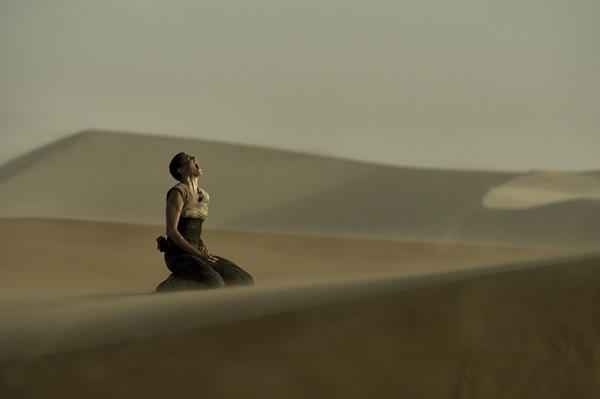
Is Mad Max Fury Road a success at the Box Office?
Maybe the MRA/GuffleGab crowd—which suggested a boycott of MMFR due to its feminazi lies—is crowing about the film not hitting #1 at the BO, proving people don’t want to see a movie with a strong female lead, but it was beaten by Pitch Perfect 2, a girl-aimed movie about an all girl singing contest with a mostly girl cast, a first time female director—congrats Elizabeth Banks!—and a 75% female audience. MMFR had a 60% male audience. This was a pretty straightforward win for girl power—$70 mil to $44.4 mil. All this led Pitch Perfect producer Lynda Obst to crow a bit:
64m weekend for Pitch Perfect 2 beats MadMax!! Here come the Girls;the Frozen Generation to take over the box office! Watch out Caped Heroes
— Lynda Obst (@LyndaObst) May 16, 2015
It also explains why that awful Jem and the Holograms trailer has a title that reads “From the studio that brought your PItch Perfect.” We have a new tentpole here, and people are going to be chasing it for a while.
Deadline’s Anita Busch put an even gloomier spin on it:
This $200M+ budgeted road rager from Village Roadshow was definitely restricted by its R-rating but there’s no pr company in the world that can put a great spin on this opening weekend. Everyone wanted this one to open better.
Mad Max triumphed worldwide with $109.4 mil, which sounds pretty good until you remember that this movie cost $200 million. All those Cirque du Soleil stunts and practical effects did not come cheaply, oh no. I’ll get back to that in a minute. As you probably know, MMFR had a very troubled production, with fits and starts for 15 years, and a worried set visit by WB’s Denise De Novi to find out what was costing so much and why Tom Hardy and Cherlize Theron didn’t get along. While there’s already hopeful talk of a sequel, to be called Mad Max: The Wasteland, this is not a no-brainer. In fact, it’s a total brainer, so we’ll have to wait and see. In the meantime, Miller and Co have turned to the far more economical world of comics to tell more of the backstory. Smart move, Vertigo!
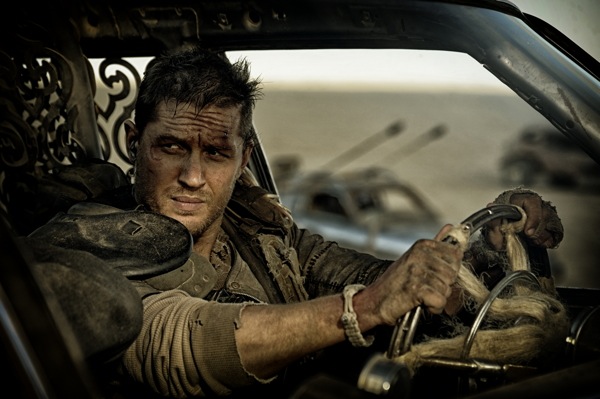
Is Tom Hardy as Mad Max awesome possum?
Yes.
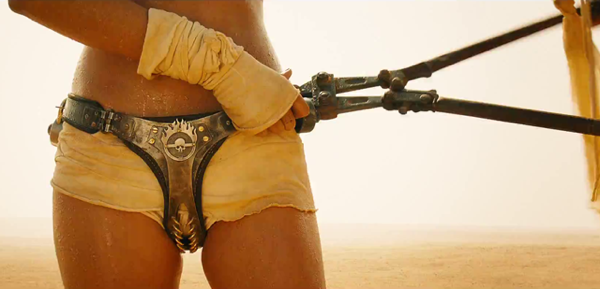
Is Mad Max Fury Road a feminist triumph?
1) On first thought, as everyone now knows, George Miller intended this to be explicitly feminist in its message, and even got playwright/activist Eve Ensler (The Vagina Monologues) on set as a consultant. And looking at the story of Imperator Furiosa (Cherlize Theron) seeking redemption by rescuing the five wives (who had already graffiti’d up their living quarters with empowering slogans) of the grotesque Immortan Joe with the aid of a bunch of exiled old ladies on bikes called the Vuvalinis does make it sound a bit didactic. So yes. But…
2) On second thought, I’m of the generation that followed humanism long before we heard about intersectionality. I know, I know, humanism is way out of fashion, but I can’t help framing the journey of Furiosa, the Splendid Angharad, the Valkyrie and the rest as simply interesting characters who struggle and triumph just the way men always have. Charlize Theron herself pointed out out that
People keep saying ‘strong women’ but we are actually just women. We had a filmmaker that understood the truth of women is powerful enough and we don’t want to be put on pedestals or made to be unnaturally strong.
3) But on third thought….man alive, this movie goes right back to the White Goddess with an explicit war between patriarchal and matriarchal values. I know some female writers have been disturbed by the childbirth scene because, well, it’s tough. But it’s a clear indication of how Immortan Joe and his crew view gender, a view sadly prevalent in the real world, where the existence of a dead male fetus is of more importance than any living female. Furiosa, the Valkyrie, Max and Nux are fighting for a more giving society, one where scarce resources are used to build a society, not to govern one. That this brainy idea is the driver for the most visceral action movie in a decade makes its triumph all the more remarkable…but I would argue that it’s a (barely hidden) subtext that gives the movie its strength. We’ve seen a gazillion action movies where the good guys beat the bad guys because of family and honor and courage and blah blah blah. Mad Max Fury Road is direct…but it isn’t simple. It’s this refreshing refusal to talk down to its audience that is so thrilling. It’s the difference between being taken for a ride and going for a ride.
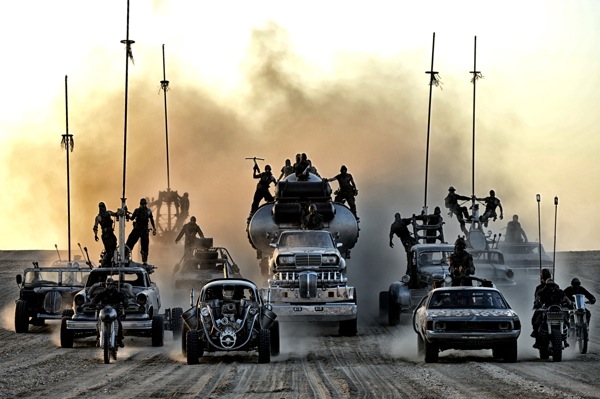
Why was that ride so thrilling?
During the long, brutal winter of ’14-’15 I spent many a night huddled under a blanket watching movies. One of the films viewed was James Cameron’s True Lies, which was made in 1994 and was the last huge action movie that used practical stunts and sets. They really blew up that bridge, and really mounted a harrier jet on a crane so Arnold could clamber over it. Jamie Lee Curtis really jumped onto a helicopter. It cost a lot and wasn’t a huge success, and now these things are all CGI and green screen.
The original Star Wars trilogy and even the Lord of the Rings trilogy used miniatures and guys in suits. The prequels and the Hobbit movies used tons and tons of CGI and in the case of the latter, Peter Jackson even turned Billy Connolly’s Dain into a CGI character. To no good effect. Little kids like the prequels just as well, but most people who like movies find the originals much more engaging and real. The Tolkien stuff is a perfect example of one set of films remaining vital and thrilling while the other is just bleh. Admittedly, one has way better material, but all that animation was ultimately numbing.
It’s obvious that the realness of Mad Max is the main reason people have reacted so strongly to it. Those were real cars, real guys on poles, real deserts, real stunts, real make-up. Of course, there was CGI, but it aided the reality instead of becoming a substitution for it—Charlize Theron’s stump of an arm being a perfect example
I find most contemporary CGI spectacle rubbery and unconvincing. It feels like shopping at the Dollar Tree: drab and monotonous. Of course I’m also old and cranky — younger movie goers, and those used to video game CGI, have no problem with it. But it’s all so lazy. One big or monster can be truly chilling—cf. Stan Winston’s work in The Thing. But that takes real time and care, so an army of CGI Ultrons, or Chitauri or bugs or orcs or whatever swarms the screen with all the spectacle of an iPhone game.
Practical effects are more expensive and take a lot more skill. It’s why its a vanishing art. Mad Max Fury Road is a profoundly 80s movie: it’s touchstones, like the old Mad Max movies, are heavy metal and hot rods and leather jackets. The filmmaking is also 80s standard for stunts and models, with contemporary CGI wizardry thrown in as the seasoning. But the rapturous response to the film made me wonder about the psychological distinction between real and unreal. Yes, we’re back in the Uncanny Valley, the theory that people are attracted to unreal, cartoonish characters but as these characters become more human and realistic, they reach a point where they are actually disturbing and repulsive. Many Robert Zemeckis films are proof of this (Polar Express ho!) We’ve moved a bit beyond Zemeckis’s early efforts, or the now laughably unconvincing swinging Spider-Man of the first Sam Raimi films, now less engaging than the guy in a Godzilla suit of the 50s.
But is there any evidence for this effect beyond constant kvetching about “all that CGI”? I googled “psychological effects of CGI” and found very little easily accessible research. (one of the top results was “Physical, Sexual and Psychological Effects of Male Infant Circumcision: an Exploratory Survey” however.)
Here’s one article from 2011 examining the Uncanny Valley:
In other experiments, MacDorman’s team showed that people feel particularly disconcerted when characters have extremely realistic-looking skin mixed with other traits that are not realistic, such as cartoon eyes. Furthermore, in a 2009 study in which participants were asked to choose the eeriest-looking human face from among a selection, the researchers found that computer-rendered human faces with normal proportions but little detail were rated eeriest. When the faces were extremely detailed, study participants were repulsed by those that were highly disproportionate, with displaced eyes and ears. In short, viewers seemed to want cartoonish facial proportions to match cartoon-level detail, and realistic proportions to match realistic detail. Mismatches are what seemed eerie.
A hopeful piece from the BBC in 2013 suggested that special effects might be going practical again, but focused on the budgetary angle. And Cartoon Brew wondered why Practical Effects Get Replaced with CGI? but it’s a video and I don’t have time to watch.
Doubtless, there is a lot of research that studies how humans react to things that are really real and things that seem real…but the time I spent googling didn’t reveal much. I’m sure Mad Max will reignite the debate and this remains a topic for further study.
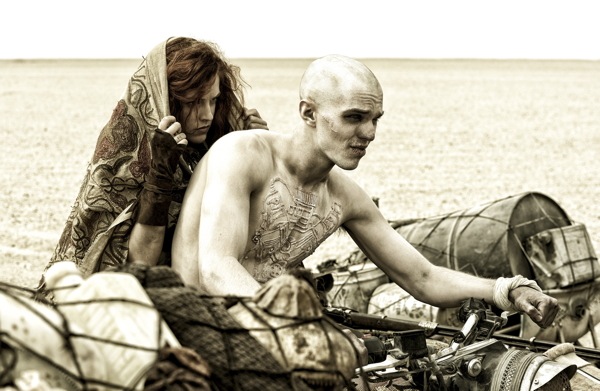
But wasn’t Mad Max Fury Road racist?
The visionary, unsurpassed imagination of artist Brendan McCarthy—co-writer and concept artist—is a huge part of what made MMFR so memorable. Sadly, he’s also been caught making many racist statement in recent years, so it’s hard to praise him without reservations. But yeah, he is awesome as a creator.
But not everyone liked Fury Road. A tumblr user going by Xmaslemmings whose real name I am not smart enough to figure out summed up the racist, ableist, fan-phobic aspects of the film:
Then, like, just look at the fact that they were stoked to work with this guy, that they shot most of this movie in Namibia with an almost exclusively white cast. Look at postapocalyptic fiction of this sort which largely aims to shift the structures of postcolonial Western genre works into a fictive precolonial (or just colonial) state where we can enjoy Cowboys versus No-Longer-Recognizable-As-Indians, open terrain, tribes to fight, lands to claim and to settle. Fury Road, like a lot of these stories, postures as only whiteness speaking to whiteness about whiteness (or substitute for whiteness: a primitive yet “postracial” civilization in which race has inexplicably not been reasserted as a central basis for organizing violent hierarchies of power) but from whom did the filmmakers borrow this imagery of tribal desert life? From whom did these cultures get their spears, their warpaint, their war drums? How have these retained their use as signifiers of barbarism and from where did that significance originate? I think the movie’s answer is: from nowhere. From a mountain with a steering wheel carved into it. As the movie ends with Furiosa ascending to traditional White Saviorhood (most of the only people of color I can recall seeing in the film being in the grateful crowd hailing her as their new queen, or whatever) there’s a quote from “The First History Man” to “sort of jokingly” suggest a universal profundity of the film’s plot and non-ironically underscore that this fantasy is a tabula rasa in which white experience has been miraculously universalized without the need to dismantle white supremacy because the violent establishment of white supremacy did not occur, or something. That isn’t unique to this film. It describes a zillion stories a white author’s ever written in this genre, such as this film, shot in Africa with a mostly white cast, which happens to also have at least one clearly white supremacist voice among its principal originating collaborators.
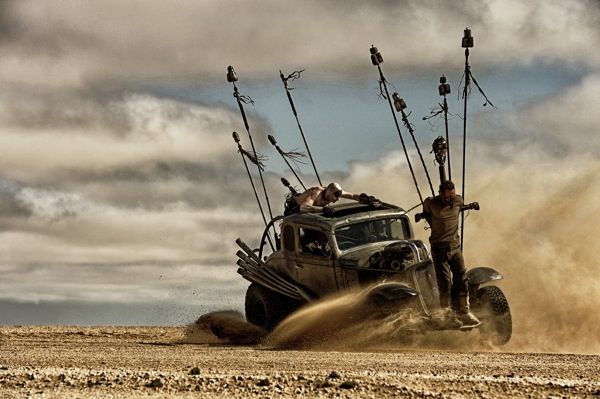
But was it still wonderful?
I hope so. There’s a takedown on MMFR’s feminism at the right wing Breitbart site, but even the critic has to admit it looks great, and the commenters seem to have forgotten the awful feminist agenda because of the great stunts. I think the last movie that pretty much shut up all its critics with its imagination and stunning visuals like this was the original Sin City. I’ll leave this with a quote from Warren Ellis, who has a way with words:
You forget that the MAD MAX films are a narrative continuum, from the brink of societal collapse all the way through to the petrol- and water-cults after the end of the world. Max himself goes from tightly-wound cop to broken man to the Max of FURY ROAD, who, for the first half of the film, is pretty much a grunting animal on his hind legs and then reduced down to a bag of blood. From husband and father to medical object.
Someone said to me the other day that MAD MAX is “his Star Wars.” His modern myth. A myth of the time of steel and petrol, that’s about collapsing back into dark history. Viewed as a continuum, the film cycle almost plays as a warning sent ahead to us from 1980. A time capsule that’s still telling itself stories from inside its box. FURY ROAD doesn’t feel like a modern film. It’s a throwback to classical filmmaking. A scream from the nightmares of the last century.
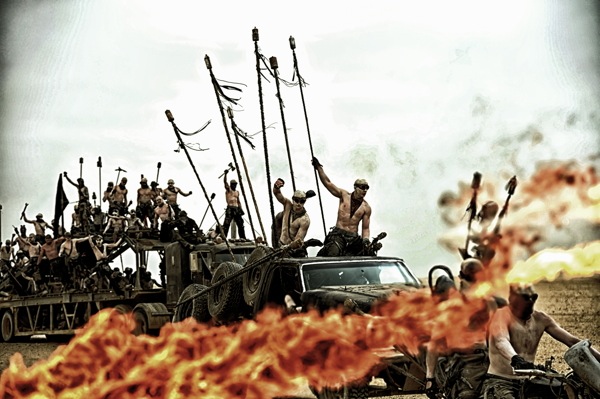
How Much Did The Beat love Mad Max Fury Road?
So much that I spent half an hour on the WB media site downloading the stills just so I can look at them again and again until I go to the theater to see it again.
Oh my…
That’s a decent way to start a review, right? After walking out of tonight’s screening of Mad Max: Fury Road, I had so much built up energy inside of me, I literally had to jump around outside of the theater. Quite a few critics have been hailing George Miller‘s return to his seminal franchise as a “masterpiece”. As far as movies that live and die on their action spectacle go, you can consider me one of the converted.
This fourth entry in a series that hasn’t seen a new film in 30 years is basically a reboot, though you could also see it as a sequel to Beyond Thunderdome in a sort of James Bond sense. Tom Hardy steps into the role originally inhabited by Mel Gibson, and his version of Max Rockatansky basically picks up where his predecessor left off. The world has continued to devolve into a hellish landscape in a way that would make George Romero jealous, but any newcomer to Miller’s post-apocalyptic fever dream will find themselves easily able to grasp the central details: Max is a former cop whose family was murdered, and he now wanders this scorched earth attempting to survive. Max gets caught by the minions of Immortan Joe (Hugh Keays-Byrne), a sort of steampunk Darth Vader/Papal-figure, who is treated like a savior by his men and farms women for their wombs and breast milk. While Max is imprisoned, Joe’s leading lady, Imperator Furiosa (Charlize Theron) makes a break for it with his prized concubines, which sets off a chain of events that finds Max, Furiosa, the neurotic yet redeemable Nux (Nicholas Hoult), and a set of kick-ass ladies (Rosie Huntington-Whiteley, Zoe Kravitz, Riley Keough, Abbey Lee, and Courtney Eaton) on a wild chase as they attempt to lose Joe’s rolling army in dusty desert.
Allow me to emphasize the word chase, as this activity is what makes up literally 99% of Fury Road‘s running time. This is a film that is pretty thin on plot, but bustling with sheer momentum, action set-pieces, intricate design work, and the most rocking score I’ve heard in a film of this type in some time. Through the mostly desert surface, Max and company are pursued by white painted men with explosive muskets, pirates with spiked cars, mercenaries wearing clothes made of bullets, and of course Joe himself. On display is literally every deathrace cliche reinvented for the screen and taken to the next logical extreme. It’s a film so high octane, that Miller even speeds up the action, and envelops it in biting humor, in a move reminiscent of the work of Jean-Pierre Jeunet; and it goes to show that Miller, even at 70, is a filmmaker is still willing to learn and adapt to new influences. Mad Max: Fury Road feels like the work of a much younger and hungrier director, and his collaboration with comics giant Brendan McCarthy (who both co-wrote the screenplay and provided much of the design work, and boy does it ever show!) may have done much to reinvigorate Miller post-films like Happy Feet.
However, despite the onslaught of Michael Bay style pyrotechnics, Miller still takes the time to give focus to the character dynamics of this rag-tag bunch that’s formed by circumstance. Rather than cardboard cut-outs, each character feels like a fully-fleshed individual via sparse dialogue and taut performances. The script is the definition of “show, don’t tell”, as exposition is kept to an absolute minimum. Perhaps the biggest and most welcome surprise is that Max isn’t even really the star of the show, though Hardy is quite good in the role, as that honor goes to Furiosa. Theron’s shaved head, mechanically-armed warrior may very well be the closest thing we’ve had to a new Ripley, and I think you can easily argue that this is Theron’s Aliens. I doubt she’ll be up for Oscar consideration, as this is the kind of film that voters almost never go for (Sigourney Weaver‘s nomination came when the field for actresses was relatively slim), but I would wholeheartedly support a Best Actress campaign in this case. She’s that good.
This added focus on Furiosa also underscores an important point; it’s one of the most feminist action films in recent memory. Fury Road centers on a group of women taking their own agency and pushing against patriarchal rule. While this franchise has always had an undercurrent of pacifist themes, Miller has laser-focused his message, to a point where one interaction at the midway point of the film ends up stating the obvious: this is what happens when old white men run the world unchecked. That may rankle some feathers in the audience, but this is an action movie that isn’t just empty spectacle or aiming for the lowest common denominator. This is a motion picture that’s actually about something with a strong point of view, and that’s worth standing up and applauding for. It’s basically the film equivalent of an album by The Clash dropping in the middle of a sea of bad arena rock.
Mad Max: Fury Road began filming in 2012, and had to undergo reshoots in 2013 (and this of course follows the 25 years of development hell that the film underwent just to get to there). We often take issue with productions that have to undergo that dreaded process, but Mad Max: Fury Road is a diamond of an exception and proves that as an audience, it behooves us to trust in auteur vision, especially in the action arena which so sorely needs it. Much like Bong Joon-ho‘s Snowpiercer last year, Miller paves the way for what these films should look like and the level of care that needs to go into them. This effort proves that, sometimes, you really can go home again.
To every other movie releasing this Summer: good luck!
– Avengers: Infinity War, which it’s been revealed will have a grueling nine month production schedule (it is two films after all), will also be shot completely in IMAX using IMAX and ARRI’s next gen 2D digital camera. This marks the first time a Hollywood feature film has ever been shot completely with IMAX cameras and utilizing its larger aspect ratio.
Here’s a statement from the Russo Bros on this announcement:
The intent with the Infinity War films is to bring ten years of accumulative storytelling to an incredible climax. We felt that the best way to exploit the scale and scope required to close out the final chapter of these three phases, was to be the first films shot entirely on the IMAX/ARRI Digital camera.
Some select action scenes of Captain America: Civil War will also utilize the IMAX camera and format.
– This week, the broadcast networks are finalizing their pick-up decisions and what will make it onto the Fall and Spring schedule. Supergirl, for example, was picked up for a full series order yesterday by CBS, while iZombie was also renewed by The CW. The Flash and Arrow have also already been renewed for their second and fourth seasons respectively.
Now, all eyes are on ABC and NBC, as the former will be making its decisions regarding Agents of S.H.I.E.L.D. (which will surely be renewed) and Agent Carter (where things are far more uncertain), while the latter holds the final fate of Constantine in its hands.
My prediction? Agent Carter gets renewed for another short season, while Constantine finally sees its long-expected axe.
But even Powers got renewed, so I guess anything could still happen.
– 20th Century Fox has revealed the cover art for the upcoming X-Men: Days of Future Past “Rogue Cut”, which will include 17 minutes of additional footage, including all of Anna Paquin‘s sequences that were cut from the theatrical release:
– We’re only a week away from Mad Max: Fury Road hitting theaters across the country. While critics are still embargoed at this point, there’s a lot to be excited about, which I elaborated on a few weeks previous. Here’s a new featurette for the film:
– Here’s the new poster for Ant-Man, which is sadly pretty underwhelming, though that’s kind of par for the course with most blockbuster movie posters these days. Floating heads, so many floating heads!
– And in fun stuff, it looks like Captain America vs. Crossbones has started early:
Don’t underestimate the benefit of awe. Take time to be amazed by things. By anything. By everything.
— Chris Evans (@ChrisEvans) May 7, 2015
@FrankGrillo I’m amazed you can read. Be honest, your kids are helping you sound out the words. — Chris Evans (@ChrisEvans) May 7, 2015
@ChrisEvans I can read the hospital report for you after wake up from that that little snooze your gonna take hero boy.
— frank grillo (@FrankGrillo) May 7, 2015
I’m really looking forward to Civil War.
Mad Max: Fury Road is right around the corner and based on the below trailer (that Heidi so kindly posted about previously), it looks like George Miller may very well prove that you can actually go home again:
But if that doesn’t convince you, here are three more reasons why you should plunk down money for a ticket to see this fourth film featuring everyone’s favorite post-apocalyptic road warrior:
1.) It’s co-written by Brendan McCarthy
Yep, that Brendan McCarthy, the artist and co-creator of comics like Zaucer of Zilk, Rogan Gosh, and Skin. Given that he and Peter Milligan‘s wonderful comic Freakwave was inspired by Miller’s Mad Max 2, it’s fitting that the two creators would eventually collaborate in this way. Additionally, McCarthy designed a number of the characters and vehicles that will feature in the new film.
2.) The first trailer for Batman v Superman: Dawn of Justice will premiere before it
Though you’ll probably see it here first, given how trailers pop up online before they make it to the big screen, it’s been confirmed that our first REAL look at what Zack Snyder and co. have been up to in a project that’s been rather shrouded in secrecy, beyond the official cast photos we’ve seen. Additionally, Junkie XL (who scored Mad Max: Fury Road) and Hans Zimmer have written new music for the trailer, as a bit of a preview for their scoring collaboration in the Man of Steel sequel.
3.) Tom Hardy is already signed up for three sequels
In a recent interview with Esquire, the new Mad Max, Tom Hardy, stated that he’s already contracted for three more films in the series provided it does well enough at the box office to warrant further desert adventures. Apparently, Miller already had plans in place to shoot the sequel to Fury Road, entitled Mad Max: Furiosa back to back with the about to be released film. That didn’t end up happening, but a screenplay is already in place. Who wouldn’t want more George Miller madness gracing our cinemas every few years?
Mad Max: Fury Road opens on May 15th and much like Snowpiercer and Dredd before it, it may very well be the action movie that we’re all still talking about months from now.
That scene absolutely had consequence. The owner died, it released the dinos who then killed dozens and dozens of people. The very thing I enjoyed about JW is that it DIDN’T try to make it a world-wide calamity. The danger was cramped and stuck to the island.
It was silly, some dialogue was cheesy, and it was fun. I really enjoyed it. It also captivated the children (14 yrs old) I took to see it. They were enamored by it. Mad Max wasn’t for them. This was.
So the director becomes the second unit?
“Go film some location shots while we work on the CGI battle sequence.”
It’s like how the fight choreographer in a kungfu movie gets almost as much credit as the director.
But once a series is formulaic, it doesn’t matter who the director is.
Writer? Sure. Get a good script, and the directing and editing becomes a lot easier.
POP QUIZ: Name TWO directors of the James Bond movies!
Who directed the Fast and the Furious movies?
If s/he balks at the salary, you find someone else to direct.
I don’t know what the term is, but there is a fine line with CGI sequences, similar to the “uncanny valley”. “Blockbustered”?
I got tired of the blurry, rapid film editing battle sequences of The Transformers. I couldn’t keep track of the choreography, I had no sense of direction or space, or who was beating the sprockets out of whom. Man of Steel has this problem as well.
But on the other extreme, I was disappointed in both Avengers movies. The threat wasn’t that big, there was little sense of urgency or despair as the heroes have to overcome overwhelming odds to Save The Day. There’s nothing to cheer for. (And if you don’t engage the audience, then where’s the box office? If people don’t rave about this or that, where’s the word of mouth? The repeat viewings? The long tail of ticket sales, which help the theater owners pay the rent?
Jurassic Park was the Poseidon Adventure with bioengineered rats. Jurassic World seems more like a Godzilla movie (as some of my friends have suggested, and a better movie than the latest GZ). Me? I gave up after Lost World.
You don’t need a lot of CGI to make great popcorn movies. Wrath of Khan was almost all visual effects (aside from the Genesis briefing). That nebula cloud? Latex rubber and ammonium mixed into a tank of fresh and salt water. Stop motion animation. Giant models.
This idea that Avengers 2 failed is weird to me. It made $444 million in the US and 1.35 billion world-wide. This is terrific.
As the expository dialog went on at the beginning of the film, talking about how the public is no longer excited about mere dinosaurs, and now needs a hybrid dinosaur with mutant powers to sell tickets, I was assured that Hollywood is not only cynical about its audience, it is open about it.
And apparently correct.
Name 2 Directors of the Bond Films? I can name 5 off the top of my head:
Terence Hill
Guy Hamilton
Martin Campbell
John Glen
Sam Mendes
Each of the directors had their own distinctive style in the franchise, with Mendes at the top of the list for “most artistic”.
I guess I should add:
John Glen directed all the Bond films of the 80’s. He holds the distinction of directing more Bond films than any other director (the second one being Guy Hamilton). He also directed two different actors in the role of Bond, Moore and Dalton.
Do’h! Where is my edit button when I need it???
I meant to type Terence YOUNG, not Terence Hill. Terence Hill was the actor in “My Name is Nobody” and “Superfuzz”.
Terence Young also directed movies such as “Wait Until Dark”.
(whew!)
Curtis, the Bond franchise is 50 years old and goes back to an older style of moviemaking. And SKYFALL was my favorite movie of the last 10 years up until MAD MAX because so much of it was practical — that mind boggling Shanghai fight scene was done IN CAMERA and it shows.
“Jurassic World” may not arguably be a superhero film, but its certainly a comic book-style film, ala “Raiders of the Lost Ark” or Edgar Rice Burroughs-style book series such as Pellucidar.
I’ve seen tens of thousands of films over the years and I had few problems with “Jurassic World” as a solid, well-crafted action flick. It met or exceeded most people’s expectations, beat out the first two sequels story and execution-wise, and was arguably better than “Jurassic Park.”
If they keep it up, further sequels will be like printing money.
Jurassic Park will always be #1. But JW: Lost World? Ugh. Please save us all from Ian Malcom. ;) And while the third one tried to bring back the shine (and was better than #2) Jurassic World officially made itself the second best of the franchise!
My boyfriend’s niece was next to me, and after the movie I asked for a 1-10 rating. She said “7”. I said “7?! Wha?” Then I asked if it was better than the two sequels. A short pause and then a “Yes!” Also, my boyfriend (who was worried the entire movie would be nothing but people running from dinosaurs (uh, uhm, let’s not even) clapped at the end of the movie, which is his true stamp of approval. It was a huge amount of fun! Everyone is SO bitter, and jaded about everything anymore. You will NEVER get back that moment of amazement you had when you saw the first one. It’s just not possible. It’s Jurassic Park. You know what you’re going in there for.
Put me down as one of those who was completely underwhelmed by Jurassic World. Summer popcorn movies have to have a couple of things for me: thrilling action with a few twists I’ve never seen before, a couple of fun, repeatable lines of dialogue, an able, resourceful hero to follow and a single-minded villain you can hiss at. I think of all those things, Chris Pratt came to the party as that type of hero, but no one else showed up ready to play (especially the director and the many screenwriters).
A couple of things that bugged me:
– Yes, Bryce Dallas Howard running around in her all-terrain high heels drove me nuts too. In the old days of action films, finally ditching the heels would be an easy metaphor for showing how the uptight heroine was loosening up and growing as a character. Now, fashion sense rules over all?
– Vincent D’onofrio’s villian wasn’t much of one. All he did was huff and smirk a few times, call in the mercenaries and (SPOILER ALERT) die.
– Speaking of those mercenaries (ANOTHER SPOILER ALERT), they’re the best soldiers money can buy and that’s the best they could do? They know they’re going up against a super T-rex and no one brings along a couple of super Jack Kirby weapons to blast it? And couldn’t any of them be more then ‘red shirts’? Where’s the Jesse Ventura-like character from Predator when you need him? At least The Lost World had Pete Postlethwaite as a gung-ho hunter to add some spice to the proceedings.
– And speaking of food additives, what made the original Park so much fun was the Jeff Goldblum character. This film disparately needed his cynical vinegar to add some bite. In the entire cast, there wasn’t a curve ball character in the bunch.
– Also, please don’t mention Raiders of the Lost Ark in the same breath as this movie. Speilberg knows how to set up an action sequence as an elaborate Rube Goldberg device — with one peril tumbling into the next. And even when we know he won’t kill a kid in a movie, we don’t have time to think about it because we’re watching him juggle so many balls in the air at the same time. Compare the sequence in the original movie where Sam Neil is trying to rescue the kids in the jeep being attacked by the T-rex and compare it to any of the scenes with the imperiled kids in this new film. It’s like comparing a ticking bomb to a cap gun.
– In fact, I thought the dinosaurs in the first film were much more terrifying! Was there any thing here to equal the menace of the Velociraptors? Or the raptors in the kitchen sequence?
– And finally, I know I need to suspend disbelief in a film like this (and I’m willing to), but even on it’s own terms it’s difficult to imagine that that raptors could be trained by Chris Pratt’s character in any way, shape or form. That works in The Flintstones, but not here. It reminds me of the documentary about the guy who tried to live in the wild with grizzly bears and be their friend — until the day they ate him.
I think the only thing left for a sequel to Jurassic World is if Dr. Wu engineers himself some Sleestak or Silurians. I’ve been half-expecting to hear about a reference in the film to the hypothetical humanoid saurians that might have evolved if the meteor/comet had never struck the Earth.
Now I’m waiting for the Marvel announcement regarding the “Devil Dinosaur” film.
I was entertained by “Jurassic World”, liked it better than “Avengers: The Age of Ultron”.
For me the major plot hole is, even if discounting the two previous sequels as non-canon, after the events of the first film, would’t you implant a micro-explosive in the brain or heart of the predatory dinosaurs just in case of the emergency like they experienced in JW?
And there’s not more than 1 helicopter pilot on that island?
I had fun watching it, but a few days later can hardly remember anything about it. It was a shallow and forgettable movie, with almost no character development.
Chris Pratt played a generic macho man. Kept waiting for him to say or do something funny, but aside from his line about being in “the Navy, not the Navajos” (which got the only big laugh at my screening), it was a dull performance. And Bryce Dallas Howard played the stereotyped neurotic, scatterbrained career woman.
No wonder it’s a huge blockbuster — especially in China, where character development doesn’t seem to matter, as long as the CGI is spectacular enough.
The Dissolve had an interesting article about JURASSIC WORLD as a “genetically modified blockbuster,” with bits and pieces (and subplots and characters) borrowed from other movies. ALIENS seems to be a favorite target for pilfering.
http://thedissolve.com/feature…
I spent the entire movie thinking Jessica Chastain was the leading lady. Then the credits came up and I discovered I’d been watching Bryce Dallas Howard for 2-plus hours.
Apparently I’m not the only one who has trouble telling them apart. Film critic Sam Adams jokingly twittered: “Jessica Chastain and Bryce Dallas Howard are different people, but they fill in for each other at social occasions.”
“POP QUIZ: Name TWO directors of the James Bond movies!”
Off the top of my head: Terence Young, Guy Hamilton, Lewis Gilbert, Peter Hunt, Irvin Kershner, Sam Mendes. That’s’ five. I’m sure there are others.
“Who directed the Fast and the Furious movies?”
Rob Cohen, Justin Lin, James Wan.
All these directors have more style than Colin Trevorrow. But his first film, the low-budget indie SAFETY NOT GUARANTEED, showed some promise.
Heidi MacDonald said: “These days moviemaking is just too expensive and leviathan to take chances.”
It depends on what kind of movie you’re making and what kind of audience you’re going after. When you’re making a CGI-packed superhero or other franchise movie that costs $200M to make and another $100M to market, you’re not going to take chances. The only way the movie can make a profit is to play everywhere in the world (especially Asia) and appeal to “everyone.”
The escalating cost of moviemaking at the major-studio level is a big reason why Steven Soderbergh abandoned movies for TV. He recalled that just lighting the casino set in OCEAN’S 13 cost $30,000 a day.
Also: Soderbergh says the studios are now run by people who don’t like movies and don’t watch them for entertainment. They’re run by people like Kevin Feige: people who know nothing about movies but everything about branding, marketing and merchandising.